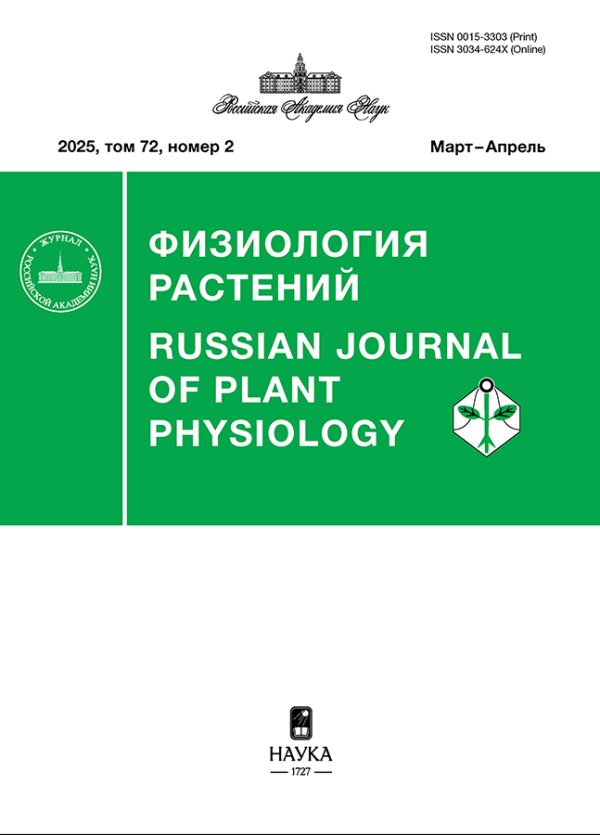«Influence of Excess Zinc on the Activity of Components of the Antioxidant System in Brassica juncea L. (Czern.) and Sinapis alba L. Plants»
- Authors: Nilova I.A.1, Repkina N.S.1, Kaznina N.M.2
-
Affiliations:
- Institute of Biology, Federal Research Center Karelian Scientific Center, Russian Academy of Sciences
- Institute of Biology, Federal Research Center Karelian Scientific Center
- Issue: Vol 70, No 5 (2023)
- Pages: 506-513
- Section: ЭКСПЕРИМЕНТАЛЬНЫЕ СТАТЬИ
- URL: https://journals.rcsi.science/0015-3303/article/view/139783
- DOI: https://doi.org/10.31857/S0015330323600183
- EDN: https://elibrary.ru/WWNQPF
- ID: 139783
Cite item
Full Text
Abstract
Under the conditions of a growing experiment, the authors studied the effect of zinc at concentra_x0002_tions of 5 (control), 50, 100, and 150 mg/kg substrate on growth, the intensity of lipid peroxidation (LPO), and the activity of the components of the antioxidant system in Brassica juncea L. (Сzern.) variety Slavyanka and Sinapis alba L. cultivar Belgium plants. Some differences and similarities were found in the AOS response of the studied species to an excess of zinc in the root environment. Thus, there were no changes in the inten_x0002_sity of lipid peroxidation in B. juncea under the influence of zinc in high concentrations, despite the high con_x0002_tent of the metal in the roots and shoots. At the same time, even in the presence of metal at a concentration of 50 mg/kg substrate, an increase in the activity of guaiacol peroxidase (GPX) and catalase was observed. In S. alba at high concentrations of zinc in the substrate, the metal content in the shoots was higher than in B. juncea. At the same time, the content of malondialdehyde noticeably increased, despite the increased activity of superoxide dismutase and GPX. In both studied plant species, an increase in the zinc concentra_x0002_tion in the substrate to 50 mg/kg and above led to an increase in the level of proline, while the content of carotenoids decreased. Considering that, in the studied concentrations, the metal had a less strong negative effect on shoot growth in B. juncea compared with S. alba, it was concluded that plants of this species are more resistant to excess zinc in the root environment.
Keywords
About the authors
I. A. Nilova
Institute of Biology, Federal Research Center Karelian Scientific Center, Russian Academy of Sciences
Email: im-ira@mail.ru
Petrozavodsk, Russia
N. S. Repkina
Institute of Biology, Federal Research Center Karelian Scientific Center, Russian Academy of Sciences
Email: im-ira@mail.ru
Petrozavodsk, Russia
N. M. Kaznina
Institute of Biology, Federal Research Center Karelian Scientific Center
Author for correspondence.
Email: im-ira@mail.ru
Petrozavodsk, Russia
References
- Mourato P.M., Moreira I.N., Leitão I., Pinto F.R., Sales J.R., Martins L.L. Effect of heavy metals in plants of the genus Brassica // IJMS. 2015. V. 16. P. 17975. https://doi.org/10.3390/ijms160817975
- Zeremski T., Ranđelović D., Jakovljevic K., Jeromela A.M., Milić S. Brassica species in phytoextractions: real potentials and challenges // Plants. 2021. V. 10. P. 2340. https://doi.org/ 10112340https://doi.org/10.3390/plants
- Bortoloti G.A., Baron D. Phytoremediation of toxic heavy metals by Brassica plants: A biochemical and physiological approach // Environ. Adv. 2022. V. 8. P. 100204. https://doi.org/10.1016/j.envadv.2022.100204
- Małecka A., Konkolewska A., Hanć A., Barałkiewicz L.C., Ratajczak E., Staszak A.M., Kmita H., Jarmuszkiewicz W. Insight into the phytoremediation capability of Brassica juncea (v. Malopolska): metal accumulation and antioxidant enzyme activated // IJMS. 2019. V. 20. P. 4355. https://doi.org/10.3390/ijms20184355
- Balafrej H., Bogusz D., Triqui Z.A. Guedira A., Bendaou N., Smouni A., Fahr M. Zinc hyperaccumulation in plants: a review // Plants. 2020. V. 9. P. 562. https://doi.org/10.3390/plants9050562
- Xu J., Chai T., Zhang Y., Lang M., Han L. The cation-efflux transporter BjCET2 mediates zinc and cadmium accumulation in Brassica juncea L. leaves // Plant Cell Rep. 2009. V. 28. P. 1235. https://doi.org/10.1007/s00299-009-0723-1
- Xu J., Zhang Y.X., Wei W., Han L., Guan Z.Q., Wang Z., Chai T.Y. BjDHNs confer heavy-metal tolerance in plants // Mol. Biotechnol. 2008. V. 38. P. 91. https://doi.org/10.1007/s12033-007-9005-8
- Khan M.I.R., Jahan B., Alajmi M.F., Rehman M.T., Khan N.A. Exogenously sourced ethylene modulates defense mechanisms and promotes tolerance to zinc stress in mustard (Brassica juncea L.) // Plants. 2019. V. 8. P. 540. https://doi.org/10.3390/plants8120540
- Prasad K.V.S.K., Saradhi P.P., Sharmila P. Concerted action of antioxidant enzymes and curtailed growth under zinc toxicity in Brassica juncea // Environ. Exp. Bot. 1999. V. 42. P. 1.
- Feigl G., Kolbert Z., Lehotai N., Molnár Á., Ördög A., Bordé Á., Laskay G., Erdei L. Different zinc sensitivity of Brassica organs is accompanied by distinct responses in protein nitration level and patternet // Ecotoxicol. Environ. Saf. 2016. V. 125. P. 141. https://doi.org/10.1016/j.ecoenv.2015.12.006
- Du X., Zeng T., Feng Q., Hu L., Luo X., Weng Q., He J., Zhu B. The complete chloroplast genome sequence of yellow mustard (Sinapis alba L.) and its phylogenetic relationship to other Brassicaceae specie set // Gene. 2020. V. 731. P. 144340. https://doi.org/10.1016/j.gene.2020.144340
- Stanis£awska-Glubiak E., Karzeniowska J. Tolerance of white mustard (Sinapsis alba L.) to soil pollution with several heavy metals // Ecol. Chem. Eng. A. 2001. V. 8. P. 445.
- Zalewska M., Nogalska A. Phytoextraction potential of sunflower and white mustard plants in zinc-contaminated soil // Chil. J. Agric. Res. 2014. V. 74. P. 485. https://doi.org/10.4067/S0718-58392014000400016
- Soleimannejad Z., Sadeghipour H.R., Abdolzadeh A., Golalipour M. Physiological responses of white mustard grown in Zn–contaminated soilset // Acta Physiol. Plant. 2020. V. 42. P. 131. https://doi.org/10.1007/s11738-020-03119-8
- Juskulak M., Grobelak A., Grosser A., Vandenbulcke F. Gene expression, DNA damage and other stress markers in Sinapis alba L. exposed to heavy metals with special reference to sewage sludge application on contaminated sites // Ecotoxicol. Environ. Saf. 2019. V. 181. P. 508. https://doi.org/10.1016/j.ecoenv.2019.06.025
- Juskulak M., Grobelak A., Vandenbulcke F. Effects of sewage sludge supplementation on heavy metal accumulation and the expression of ABC transporters in Sinapis alba L. during assisted phytoremediation of contaminated sites // Ecotoxicol. Environ. Saf. 2020. V. 197. P. 110606. https://doi.org/10.1016/j.ecoenv.2020.110606
- Sharama Sh.S., Dietz K.J. The relationship between metal toxicity and cellular redox imbalance // Trends Plant Sci.2008. V. 14. P. 43. https://doi.org/10.1016/j.tplants.2008.10.007
- Wang Ch., Zhang S.H., Wang P.F., Hou J., Zhang W.J., Li W., Lin Zh.P. The effect of excess Zn on mineral nutrition and antioxidative response in rapeseed seedlings // Chemosphere. 2009. V. 75. P. 1468. https://doi.org/10.1016/j.chemosphere.2009.02.033
- Yang H., Zhang J., Li J. Physiological response to zinc pollution of rape (Brassica chinensis L.) in paddy soil ecosystem // Adv. Mater. 2011. V. 356. P. 39. https://doi.org/10.4028/www.scientific.net/AMR.356-360.39
- Blasco B., Graham N.S., Broadley M.R. Antioxidant response and carboxylate metabolism in Brassica rapa exposed to different external Zn, Ca, and Mg supply // J. Plant Physiol. 2015. V. 176. P. 16. https://doi.org/10.1016/j.jplph.2014.07.029
- Du J., Guo Zh., Li R., Ali A., Guo D., Lahori A.H., Wang P., Liu X., Wang X., Zhang Z. Screening of Chinese mustard (Brassica juncea L.) cultivars for the phytoremediation of Cd and Zn based on the plant physiological mechanisms // Environ. Pollut. 2020. V. 216. P. 114213. https://doi.org/10.1016/j.envpol.2020.114213
- Stewart R.C., Bewley J.D. Lipid peroxidation associated with accelerated aging of soybean axes // Plant Physiol. 1980. V. 65. P. 245. https://doi.org/10.1104/pp.65.2.245
- Beauchamp Ch., Fridovich I. Superoxide dismutase improved assays and an assay applicable to acrylamide gels // Anal. Biochem. 1971. V. 44. P. 276.
- Ershova M.A., Nikerova K.M., Galibina N.A., Sofronova I.N., Borodina M.N. Some minor characteristics of spectrophotometric determination of antioxidant system and phenolic metabolism enzyme activity in wood plant tissues of Pinus sylvestris L. // Protein Pept. Lett. 2022. V. 9. P. 711. https://doi.org/10.2174/0929866529666220414104747
- Aebi H. Catalase in vitro // Methods in Enzymol. 1984. V. 105. P. 121.
- Maehly A.C. The assay of catalase and peroxidase // Meth. Biochem. Anal. 1954. V. 1. P. 357.
- Bradford M.M. A rapid and sensitive method for the quantitation of microgram quantities of protein utilizing the principle of protein-dye binding // Anal. Biochem. 1976. V. 72. P. 248.
- Bates L.S., Waldren R.P., Teare I.D. Rapid determination of free proline for water-stress studies // Plant Soil. 1973. V. 39. P. 205.
- Wintermans J.E.G., De Mots A. Spectrophotometric characteristics of chlorophyll a and b and their phaeophytins in ethanol // Biochim. Biophys. Acta. 1965. V. 109. P. 448. https://doi.org/10.1016/0926-6585(65)90170-6
- НСАМ №499-АЭС/МС. Определение элементного состава горных пород, почв, грунтов и донных отложений атомно-эмиссионным c индуктивно связанной плазмой и массспектральным с индуктивно связанной плазмой методами (ред. 2015).
- Natasha N., Shanid M., Bibi I., Iqbal J., Khalid S., Murtaza B., Bakhat H.F., Farooq A.B.U., Amjad M., Hammad H.M., Niazi N.Kh., Arshad M. Zinc in soil-plant-human system: A data-analysis review // Sci. Total Environ. 2022. V. 808. P. 152024. https://doi.org/10.1016/j.scitotenv.2021.152024
- Alia Prasad K.V.S.K., Saradhi P.P. Effect of zinc on free radicals and proline in Brassica and Cajanus // Phytochem. 1995. V. 39. P. 45. https://doi.org/10.1016/0031-9422(94)00919-K
- Mittler R. Oxidative stress, antioxidants and stress tolerance // Trends Plant Sci. 2002. V. 7. P. 405.
- Schutzendubel A., Polle A. Plant responses to abiotic stresses: heavy metal-induced oxidative stress and protection by mycorrhizatin // J. Exp. Bot. 2002. V. 53. P. 1351.
- Dai H., Wei Sh., Skuza L., Jia G. Selenium spiked in soil promoted zinc accumulation of Chinese cabbage and improved its antioxidant system and lipid peroxidation // Ecotoxicol. Environ. Saf. 2019. V. 180. P. 179. https://doi.org/10.1016/j.ecoenv.2019.05.017
- Srivastava M., Ma L.Q., Singh N., Singh Sh. Antioxidant responses of hyper-accumulator and sensitive fern species to arsenic // J. Exp. Bot. 2005. V. 56. P. 1335. https://doi.org/10.1093/jxb/eri134
- Mohmoud A., Elgawad H.A., Hamed B.A., Beemster G.T.S., El-Shafey N.M. Differences incadmium accumulation, detoxification and antioxidant defenses between contrasting maize cultivars implicate a role of superoxide dismutase in Cd tolerance // Antioxidants. 2021. V. 10. P. 1812. https://doi.org/10.3390/antiox10111812
- Ghnaya A.B., Hourmant A., Cerantola S., Kervarec N., Cabon J.Y., Branchard M., Charles G. Influence of zinc on soluble carbohydrate and free amino acid levels in rapeseed plants regenerated in vitro in the presence of zinc // Plant Cell, Tissue Organ Cult. 2010. V. 102. P. 191. https://doi.org/10.1007/s11240-010-9721-9
- Lin M.Z., Jin M.F. Soil Cu contamination destroys the photosynthetic systems and hampers the growth of green vegetables // Photosynthetica. 2018. V. 56. P. 1336. https://doi.org/10.1007/s11099-018-0831-7
Supplementary files











